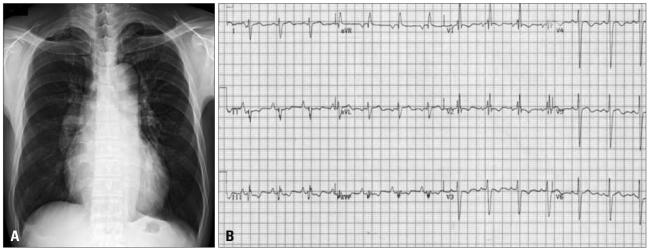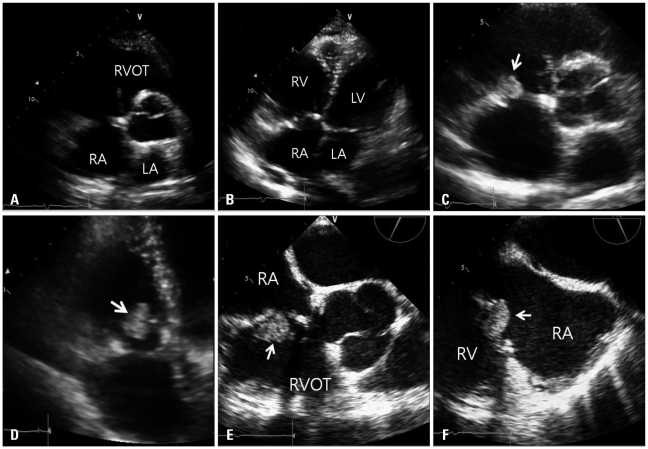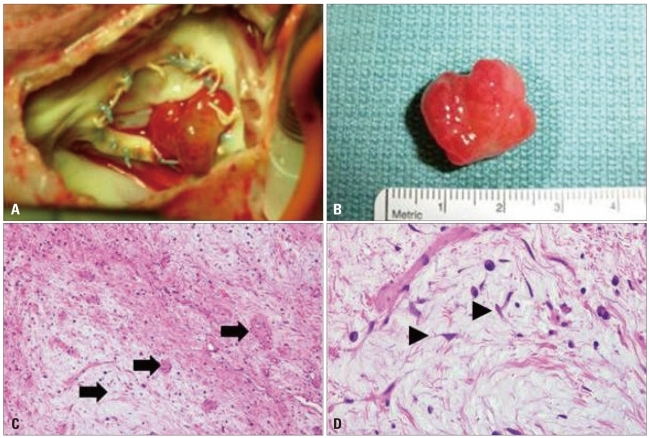J Cardiovasc Ultrasound.
2011 Dec;19(4):207-210. 10.4250/jcu.2011.19.4.207.
Tricuspid Valvular Myxoma: Unusual Case of Tricuspid Valve Myxoma Mimicking Thrombus after Pulmonary Artery Embolectomy and Tricuspid Annuloplasty in Pulmonary Thromboembolism Patient
- Affiliations
-
- 1Department of Cardiology, Inje University Ilsan Paik Hospital, Goyang, Korea. mdksu@paik.ac.kr
- 2Department of Thoracic Surgery, Inje University Ilsan Paik Hospital, Goyang, Korea.
- 3Department of Pathology, Inje University Ilsan Paik Hospital, Goyang, Korea.
- KMID: 1980385
- DOI: http://doi.org/10.4250/jcu.2011.19.4.207
Abstract
- A 55-year-old man with massive pulmonary thromboembolism underwent thrombolysis, pulmonary artery embolectomy and tricuspid annuloplasty. Nine months later, a mobile echogenic intra-cardiac mass was found in the tricuspid valve. Because the patient had undergone annuloplasty, thrombosis was suspected as the most likely diagnosis and thrombolytic therapy was instituted. However, the size of the cardiac mass did not change and after surgical excision the mass was found to be a myxoma. Cardiac valvular tumors are uncommon and when they occur they are usually slow growing fibroelastomas. In this case, the rapid growing cardiac myxoma on the tricuspid valve was found after the occurrence of pulmonary thromboembolism. To our knowledge, this is first reported case of tricuspid valve myxoma in Korea.
MeSH Terms
Figure
Reference
-
1. 2009 Training program for authenticated echocardiographist [Internet]. Korean Society of Echocardiography. 2009. cited 2011 Feb 21. Available from: http://www.ksecho.org/infomation/contents/notice126/11_1.pdf.2. Pierre-Justin G, Pierard LA. Management of mobile right heart thrombi: a prospective series. Int J Cardiol. 2005; 99:381–388. PMID: 15771917.3. Piazza G, Goldhaber SZ. Fibrinolysis for acute pulmonary embolism. Vasc Med. 2010; 15:419–428. PMID: 20926501.4. Porath A, Avnun L, Hirsch M, Ovsyshcher I. Right atrial thrombus and recurrent pulmonary emboli secondary to permanent cardiac pacing--a case report and short review of literature. Angiology. 1987; 38:627–630. PMID: 3631647.5. Mügge A, Gulba DC, Jost S, Daniel WG. Dissolution of a right atrial thrombus attached to pacemaker electrodes: usefulness of recombinant tissuetype plasminogen activator. Am Heart J. 1990; 119:1437–1439. PMID: 2112880.6. Reynen K. Cardiac myxomas. N Engl J Med. 1995; 333:1610–1617. PMID: 7477198.7. Graça A, Nunes R, Costeira A, Almeida J, Bastos P. Cardiac papillary fibroelastoma of a mitral valve chordae revealed by stroke. Rev Port Cardiol. 1999; 18:937–939. PMID: 10590658.
- Full Text Links
- Actions
-
Cited
- CITED
-
- Close
- Share
- Similar articles
-
- The Right Ventricular Myxoma Which Attached to the Tricuspid Valve: Sliding Tricuspid Valvuloplasty
- Left Atrial Myxoma Associated with Mitral Regurgitation and Coronary Artery Disease
- Pulmonary Thromboembolism and Infarction Caused by Right-Sided Infective Endocarditis in a Patient with Ventricular Septal Defect
- Tricuspid Valve Repair for Tricuspid Valve Insufficiency Following a Cardiac Stab Injury
- A case of congenital tricuspid stenosis






